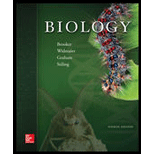
Concept explainers
Introduction: A group of organisms, which are related and share a distinctive form, is known as species. Members of the species living in a particular area at a particular time, which are capable of interbreeding, are known as a population. The population keeps changing to produce new species over time.
Answer to Problem 1TY
Correct answer: A change in one or more than one characteristic of a population, which can be transferred over several generations, is known as evolution. Hence, the correct answer is option d.
Explanation of Solution
Reason for the correct answer:
Evolution refers to the changes in one or more characteristics of a given population which can be inherited by the next generation.
Option d. is given as “evolution”
Changes in one or more characteristics of a population, which can be inherited over various generations through time, are known as evolution. Hence, the correct answer is option d.
Reasons for the incorrect answer:
Option a. is given as, “natural selection”.
Individuals having characteristics that are more suitable for a particular environment are able to survive and reproduce successfully. These individuals are naturally selected and thus, evolution is caused. Therefore, natural selection is one of the factors which cause evolution. Hence, option a. is incorrect.
Option b. is given as, “sexual selection”.
A form of natural selection is known as sexual selection. Sexual selection refers to a process through which individuals with particular traits engage in a successful mating event with individuals of the opposite sex over other individuals belonging to the same sex. Sexual selection is a factor affecting natural selection and evolution. Hence, option b. is incorrect.
Option c. is given as, “population genetics”.
The study of genetic differences present in a population by studying genes and genotypes is known as population genetics. The population genetics makes up a part of evolutionary biology. It is a study and is not responsible for causing changes in the characteristics of the given population. Hence, option c. is incorrect.
Option e. is given as, “inheritance of acquired traits”.
According to Lamarck’s theory, organisms change their behavior according to the changes in the environment. Therefore, the inheritance of acquired characteristics is based on Lamarck’s theory which was rejected as research depicted that most of the acquired traits could not be inherited. Hence, option e. is incorrect.
Hence, the options a., b., c., and e. are incorrect.
Thus, evolution refers to the changes in characteristics of the population which are inherited over time.
Want to see more full solutions like this?
Chapter 23 Solutions
Biology
- Molecular Biology Question A gene that codes for a protein was removed from a eukaryotic cell and inserted into a prokaryotic cell. Although the gene was successfully transcribed and translated, it produced a different protein than it produced in the eukaryotic cell. What is the most likely explanation?arrow_forwardMolecular Biology LIST three characteristics of origins of replicationarrow_forwardMolecular Biology Question Please help. Thank you For E coli DNA polymerase III, give the structure and function of the b-clamp sub-complex. Describe how the structure of this sub-complex is important for it’s function.arrow_forward
- Molecular Biology LIST three characteristics of DNA Polymerasesarrow_forwardMolecular Biology RNA polymerase core enzyme structure contains what subunits? To form holo enzyme, sigma factor is added to core. What is the name of the structure formed? Give the detailed structure of sigma factor and the function of eachdomain. Please help. Thank youarrow_forwardMolecular Biology You have a single bacterial cell whose DNA is labelled with radioactiveC14. After 5 rounds of cell division, how may cells will contain radioactive DNA? Please help. Thank youarrow_forward
- 1. Explain the structure and properties of atoms and chemical bonds (especially how they relate to DNA and proteins). Also add some pictures.arrow_forward1. In the Sentinel Cell DNA integrity is preserved through nanoscopic helicase-coordinated repair, while lipids in the membrane are fortified to resist environmental mutagens. also provide pictures for this question.arrow_forwardExplain the structure and properties of atoms and chemical bonds (especially how they relate to DNA and proteins). Also add some pictures.arrow_forward
- In the Sentinel Cell DNA integrity is preserved through nanoscopic helicase-coordinated repair, while lipids in the membrane are fortified to resist environmental mutagens. also provide pictures for this question.arrow_forward1. Explain how genetic information is stored, copied, transferred, and expressed. Also add some pictures for this question.arrow_forward!. Describe biological macromolecules (DNA, RNA, proteins, lipids, etc.) and how they function in the cell. also provide some images for this question.arrow_forward
 Concepts of BiologyBiologyISBN:9781938168116Author:Samantha Fowler, Rebecca Roush, James WisePublisher:OpenStax College
Concepts of BiologyBiologyISBN:9781938168116Author:Samantha Fowler, Rebecca Roush, James WisePublisher:OpenStax College Biology (MindTap Course List)BiologyISBN:9781337392938Author:Eldra Solomon, Charles Martin, Diana W. Martin, Linda R. BergPublisher:Cengage Learning
Biology (MindTap Course List)BiologyISBN:9781337392938Author:Eldra Solomon, Charles Martin, Diana W. Martin, Linda R. BergPublisher:Cengage Learning Human Heredity: Principles and Issues (MindTap Co...BiologyISBN:9781305251052Author:Michael CummingsPublisher:Cengage Learning
Human Heredity: Principles and Issues (MindTap Co...BiologyISBN:9781305251052Author:Michael CummingsPublisher:Cengage Learning
 Human Biology (MindTap Course List)BiologyISBN:9781305112100Author:Cecie Starr, Beverly McMillanPublisher:Cengage Learning
Human Biology (MindTap Course List)BiologyISBN:9781305112100Author:Cecie Starr, Beverly McMillanPublisher:Cengage Learning Biology Today and Tomorrow without Physiology (Mi...BiologyISBN:9781305117396Author:Cecie Starr, Christine Evers, Lisa StarrPublisher:Cengage Learning
Biology Today and Tomorrow without Physiology (Mi...BiologyISBN:9781305117396Author:Cecie Starr, Christine Evers, Lisa StarrPublisher:Cengage Learning





